Library Reference Number: 235
Military Aircraft at Sea - Part 2
In this second part of 'Military Aircraft at Sea', we look at the immediate post war period until the present day. To limit the scope and size of this article, no specific mention is made to the USA since this will be covered in a future article and some classes of aircraft carrier built by British shipyards are ignored. This latter decision is merely because they represented modest improvements on what had gone before. Relatively few saw war service on the same scale as some of the older vessels and the post war International use of aircraft carriers has carried political implications ever since. To explain this in greater detail, this author has digressed in some places to illustrate key background situations so that a better and clearer context can be delivered. I trust this is in keeping with the approval of the reader.
Let's say from the outset that Italy had little or no interest in aircraft carriers during the Second World War but was a major victim of an aircraft carrier launched attack on their Navy Base at Tarranto in 1940. This action is noteworthy because it was the first of its kind and became the blueprint for a much larger scale attack on the US Naval Base at Pearl Harbour in 1941.
At Tarranto, there was no radar and a mere two-dozen elderly biplanes conducted the raid from the deck of HMS Illustrious. At Pearl Harbour, radar was still being tested and evaluated so when news of many incoming planes was reported, the information was wrongly treated as a low priority. The Imperial Japanese Navy used over four hundred aircraft launched from the decks of six aircraft carriers.
More details about both incidents are given in the first part of this series (See Library Reference 174 on this web site) so I won't say more about it here. What is important to recognise is how the Japanese saw much in common with Britain prior to the war years.
Like Britain, Japan is an island located close beside a large continent. Like Britain, the political hierarchy was that of a democratic monarchy and, like Britain, the organisational features of its armed forces typically emulated that of Britain. When Japanese Admiral Togo defeated the powerful Russian fleet in 1906, (See Library Reference 174), the World Press hailed him as the 'Nelson of the East' in comparison to Britain's Horatio Nelson of Trafalgar fame. Until then, the notion of this island nation beating its bigger rival into surrender had seemed absurd.
In an equally bizarre fashion, and around that same period of time, the smaller offshore island of Britain was overseeing an Empire comprising over one third of the landmass of the planet and including about twenty per cent of the global population. Given historical variation, it could have been bigger but for the Wars of Independence fought in 1773-1776 and where the birth of the United States of America had its origin. In the opening years of the twentieth century, many prominent US citizens feared war with the British Empire might become inevitable.
It's often wrongly assumed that the torpedo attack and sinking of the RMS Lusitania while US citizens were aboard caused US entry into the First World War but that is a fallacy. The true reason was interception and decryption of the 'Zimmerman Telegram' by British Intelligence and which invited Mexico to attack the United States with German material support. Success meant return of former Mexican territories within US borders.
Sad thing is, the British couldn't reveal how they had intercepted the message or else reveal how their first generation 'signal intelligence' unit worked. To do so would have revealed the probability of their more global 'SIGINT' network and the likelihood of 'listening in on friendly nations' too. A cover story was invented but whether the US or others ever entirely believed it remains open to conjecture and is definitely beyond the scope of this article. It merely serves to illustrate how mistrust existed on both sides of the Atlantic in the years preceding World War Two. It explains why British warnings prior to the Pearl Harbour attack were dismissed.
In Japan, keen observers could see that the key to the British Empire was sea power and their ability to project armed force at a distance if needed. In the early twentieth century, Japanese policy had largely been about homeland defence but as the Japanese invaded Manchuria and elsewhere, the benefits of military expansion and conquest seemed worthy of emulation. One might argue that Japan was seeking to establish an Asiatic variant of the British Empire and spent considerable monies to establish a sea power base capable of such performance. In the years leading up to the Second World War, Japanese investment in aircraft carriers and large battleships had often brought them into political conflict concerning the Washington Treaty of 1922 concerning Naval Arms limitations but by 1936, Italy and Japan had renounced their former agreement and adherence of the Treaty and thus making the Treaty of dubious value.
By the start of World War Two, the Imperial Japanese Navy was the third largest in the World and the best equipped. By the end of the war, it had been virtually decimated and reduced to a last ditch status and never permitted to rebuild to a similar status.
Like many nations, the Japanese never had a separate air force during the war and where aircraft were operated as part of Army Air Force or Fleet Air Arm. The United States Air Force, by comparable example, began as an aviation extension of the army with the USAAF insignia on many aircraft.
Back in 1945, whatever hope there had ever been a 'Japanese Empire' akin to that of the British Empire lay in ruins and where the deployment of new-age atomic weapons had brought the war to an unexpected and rapid conclusion. Ever since, it's become popular knowledge how the US bomber 'Enola Gay' delivered the first nuclear attack in history against the city of Hiroshima on 6th August 1945. Lesser known is how the B29 Super Fortress 'Bockscar' was ordered to deliver a similar crushing blow to the community of Kokura three days later. During the flight, however, adverse weather over Kokura was deemed unfavourable and Nagasaki thus became the most unfortunate city in the World as a secondary target.
In the wake of humiliating surrender terms in 1945, Japanese armed forces were downgraded and where any need of offensive capability was removed yet permitting essential 'homeland defence' options. In the 'new order' of things, Japan would have no need for large battleships or aircraft carriers. The Japanese Fleet Air Arm was virtually disbanded and the Japanese Air Self Defence Force or JASDF was formed in 1946.
In 2013, the JASDF constitutes the principal defence arm of Japan with responsibility for radar surveillance and which includes operation of four AWACs and several E2 Hawkeye aircraft. It has about eight hundred aircraft of which approx three hundred and fifty are jet fighters.
Most numerous among these is the indigenously built variant of the McDonnell-Douglas F15 by Mitsubishi and which makes Japan the largest user of these aircraft outside of the United States. About one hundred and eighty of these are in current service.
By far, the F2 built jointly by Lockheed-Martin and Mitsubishi is regarded as the most modern option available to the JASDF with about 75 in service with more on order. Technically, it's an enlarged variant of the F16 proposed for use by the United States back in the 1980s but was rejected in favour of the Joint Strike Fighter (JSF) initiative described later in this text.
Part One of this series (See Library Reference 174) details the wartime exploits of Japanese aviation and how it all came to a ghastly end. Consequently, there is no need to repeat details here save that to say that no Japanese aircraft carriers are envisioned as a part of the future.
Given most historical accounts of World War 2, one can be forgiven if the texts suggest there was little or no German interest in aircraft carriers but that remains far from actuality.
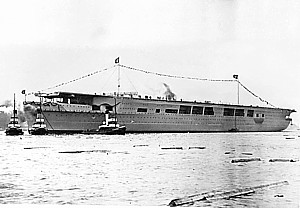 Construction of Germanys first aircraft carrier, the 'Graf Zeppelin' began in 1936 and the hull was launched in 1938. Named after the famous German airship designer, the 35,000-ton vessel was initially designed with the notion of having 30 fighter aircraft and twelve dive-bombers (marine variants of the Bf109 and Stuka) but as the needs of war progressed, these proposed numbers were reversed with twelve fighters for defence and thirty dive-bombers for offence. A sister ship of similar design was begun in 1938 but it was never completed or even awarded a name.
Construction of Germanys first aircraft carrier, the 'Graf Zeppelin' began in 1936 and the hull was launched in 1938. Named after the famous German airship designer, the 35,000-ton vessel was initially designed with the notion of having 30 fighter aircraft and twelve dive-bombers (marine variants of the Bf109 and Stuka) but as the needs of war progressed, these proposed numbers were reversed with twelve fighters for defence and thirty dive-bombers for offence. A sister ship of similar design was begun in 1938 but it was never completed or even awarded a name.
Conversion work on existing passenger ships namely Europa, Potsdam and Gneisenau, had offered the possibly of earlier service with work beginning in 1942 and where each vessel was expected to have 24 Bf109T fighters and 18 Ju87c Stuka dive-bombers. German attention momentarily shifted to a captured unfinished French light cruiser, 'De Grasse' and the heavy cruiser 'Seydlitz' and where their expected role as aircraft carriers ended even before having a chance to begin. None of the above projects were ever completed and largely on account of a singular wartime event.
On 31st December 1942, German surface warships attacked Allied Convoy JW51B headed for the Kola Inlet in Russia. It became known as the 'Battle of the Barents Sea' and while Allied escort ships did sustain losses, the entire merchant component of the convoy managed to reach its objective complete and intact.
Upon hearing this news, an infuriated Adolph Hitler decided that surface raiders were a waste of resources and ordered maximum additional effort on building U-Boats. In February 1943, all building work on German surface ships was cancelled and never restarted.
In retrospect, one can now speculate why such a crucial decision of that type was made. It is likely that, whether new build or conversion, none of the German aircraft carriers would have been fast enough to form the kind of 'battle group' being employed with great success by US forces against Japan. Germany didn't have the resources to develop 'power projection' on a similar scale in 1943 and its best options lay in development of new weapon systems like the V2 rocket, jet aircraft, better submarines and the nuclear bomb. Fortunately, none of these was perfected by the time Germany was compelled to surrender in 1945.
In the closing days of the war, the 'Graf Zeppelin' was taken out of dock and then scuttled in shallow water only to allow the Russians to refloat and recover the vessel in 1946. In 1947, the 'Graf Zeppelin' disappeared on a voyage to Leningrad amid a shroud of secrecy and where its fate remained a closely guarded secret for several decades and until the dissolution of the USSR in 1992. It's now known how the vessel was loaded with explosives and was used as a target practice ship until it sank. It was thought that Soviet pilots might get a 'flavour' of what an attack on an aircraft carrier might be like.
Such an outcome was politically wise on account of the tripartite agreement signed in wartime by the USSR, USA and UK. Russia had captured many assets like the battleship 'Lutzow' and where the desire to keep them was contrary to that agreement. 'Lutzow' fared no better than the 'Graf Zeppelin' in that respect.
In a cash starved and heavily indebted post-war Britain, economic stringency was sought out in every department of government. In a scathing defence expenditure review, the cost of maintaining large warships and aircraft carriers came under the severest critical scrutiny. The age of battleship was deemed as redundant since bitter lessons had been learned about their inability to defend themselves from aerial bombers and vulnerability to submarine attack. In a new modern navy, smaller general-purpose frigates would steadily become the new backbone of a 'blue water' fleet equipped with missiles and often with a helicopter offering greater scope and ability than before.
Britain had ended the war with more than fifty 'aircraft carriers' in service but the bulk of these were hastily converted merchant vessels fitted with a flight deck. These had been designated as 'convoy escort carriers'. In the post war era, many of these craft were restored to regular and normal civilian service with the flight deck and aircraft removed. Unfortunately, this still left a sizeable core of aircraft carriers that the country could not afford with more in building at civilian shipyards around the country.
Most had been ordered in 1942 with expectation of a longer war and where adoption of a Light Fleet Carrier Design had been chosen as a 'cost effective' solution between that of a large and expensive fleet carrier design and that of an escort carrier.
Of these, the 'Colossus' class was set to become the most numerous with sixteen ships on order. Four were completed and commissioned before the war ended but never saw wartime service. Two of them, HMS Perseus and HMS Pioneer, were fitted out as aircraft maintenance ships rather than carriers. Another, HMS Triumph, was also transferred to this role latter its career.
Four others, completed in the immediate post war years, were sold to 'friendly' foreign governments as a means to desperately needed revenue.
The lead ship of the class, HMS Colossus, was initially leased to France in 1946 and ultimately purchased outright in 1951. In her career under French management and renamed as 'Arromanches' (French warships do not have prefixes like HMS) the ship participated in military operations during the first Indo-China wars from 1948-1954 and the Suez Crisis of 1956. In 1968, she was deemed as too small to perform the role of a front line carrier and was refitted to perform the role of anti-submarine warfare (ASW) using helicopters. In 1974, she was decommissioned and then scrapped at the Toulon Navy Yard in 1978.
HMS Warrior was a Colossus class carrier originally fitted out for service in tropical waters without heating being installed. Strangely then, it was transferred to Canadian service but deemed as inadequate in a colder climate. The vessel was returned to the UK with a promise of obtaining one of the newer Majestic class carriers in building. In 1954, and following some activity during the Korean War, HMS Warrior was involved in experimental work involving fitment of a 'flexible deck' to test whether Vampire jet aircraft could land at speed without use of undercarriage or arrestor wires in a 'belly flop' type of manoeuvre. Although successful, the technique proved risky and impractical and was never implemented as a workable solution.
The ship was sold to Argentina in 1958 and renamed as 'ARA Independencia' and equipped with F4U Corsair, SNJ-5Cs Texan and Grumman S2F-1 (S-2A) Tracker aircraft. She was scrapped in 1971 soon after the 'ARA Veinticinco de Mayo' entered Argentine service in 1969.
Coincidently, the 'ARA Veinticinco de Mayo' initially started life as another of the four Colossus class carriers sold to foreign powers in the immediate post war period. In this case, it was 'HMS Venerable' that became the 'HNLMS Karel Doorman'.
Under Dutch control and management, the highlight of its career was a long voyage to the Far East ahead of the decolonisation and independence of Western New Guinea in 1960. In a politically charged situation, Indonesia was laying claim to the territory and where supporters included that of Egypt. It thus became necessary for the Dutch fleet to take the longer and traditional route around the southern cape of Africa rather than seek passage through the Suez Canal. When the fleet arrived at Freemantle in Australia, local dockworkers refused to help her enter port on account of their political support for the Indonesian claim.
Despite this, and without use of tugs, the vessel was docked successfully by using propeller driven aircraft secured to the deck to provide necessary steerage thrust to enable the ship to dock alongside the quay! It had been planned that the ship would later visit Yokohama in Japan but the uneasy political situation prompted the Japanese government to withdraw their former invitation.
In 1964, the Netherlands decided the ship was too small to serve as a front-line battle carrier and purchase of a replacement was deemed beyond the means of the National Treasury. The 'Karel Doorman' was stripped of her regular aircraft and refitted to fulfil the role of ASW (Anti-Submarine Warfare) using helicopters. Four years later, a major engine room fire disabled the vessel.
Given the severity of the damage and the need for scarce replacement parts, the Dutch government turned towards the UK for help and where the last remaining 'Colossus' class vessel, HMS Leviathan, remained incomplete. In 1969, HMS Leviathan was stripped in order to supply the necessary parts and then what remained was scrapped.
Even before the restoration and modernisation work was complete, the Dutch government had agreed to sell the ship to Argentina and where the ship was modernised and updated prior to delivery in 1969. As stated above, the 'ARA Veinticinco de Mayo' (25th of May) replaced the 'ARA Independencia' and which was scrapped in 1971.
The 'ARA Veinticinco de Mayo' was fitted out with an air group comprising a dozen French built Étendard jet fighters (Étendard means 'battle standard' in French), six Grumman Tracker ASW aircraft and four SH-3D Sea King ASW helicopters. Later in service, US built A4 Skyhawks became favoured replacements and most likely on account of easier maintenance.
It did not, however, prompt premature retirement of the Dassault Étendard fleet of aircraft since these retained the powerful ability to aim and launch Exocet air to ship missiles of which Argentina had acquired about sixteen by the time of the Falklands conflict in 1982.
The fourth Colossus class vessel eventually sold was initially loaned to the Royal Australian Navy (RAN) in 1952 and served as a training ship in lieu of a Majestic class vessel in building. Upon conclusion of the loan in 1956, the ship was acquired by Brazil and renamed as the 'NAe Minas Gerais' and where it underwent a major refit in the Netherlands that took four years to complete. It was ultimately commissioned into the Brazilian Navy in 1960 and given the task of patrolling one of the longest coastlines in the World.
In 1987, the vessel developed problems with its catapult launch facility and perhaps because of Brazilian support for Argentina during the Falklands crisis, Brazil faced difficulty in getting any support to resolve this. By then, other spare parts were being stripped from the Argentine 'ARA Veinticinco de Mayo' until the Argentine vessel was towed to Alang in India and sold for scrap. From 1987-1996, the 'NAe Minas Gerais' became classified as an assault ship using helicopters and carrying troops. It was retained in service until 2001 and followed the same route as its Argentine counterpart by being towed to Alang in India for scrapping in 2004.
There were ten Colossus ships as per original specification and variants and what remained in service with the Royal Navy were to see sterling service in the Korean War and elsewhere. During the Suez Crisis of 1956, Colossus aircraft carriers performed the first ever helicopter assault of its kind in history and where hundreds of troops were landed at Port Said from a fleet of helicopters and amply supported by tons of supplies in just ninety minutes. At differing stages following this highlight, HMS Theseus, HMS Glory and HMS Ocean were placed in reserve. HMS Triumph, as already stated, found a new career as a repair ship but all were eventually scrapped.
Ultimately, class distinction would have it that the 'ARA Veinticinco de Mayo' became the best remembered for its participation in the Falklands Invasion and subsequent actions in 1982 - and for all the wrong reasons! More on this later!
In the immediate post-war period, three major developments before forefront to the design of warships and especially aircraft carriers namely jet aircraft, helicopters and missiles.
It may surprise many to learn that Germany pioneered the latter with research involving a drum towed behind a U-Boat and where, once close enough to New York, or similar target, the drum could be rotated into a vertical position and the V2 missile inside fired from that position. These became the first submarine launched missiles in history and several were test fired in 1942 but the system was never used in anger.
Germany's pioneering work on the Me-262 jet aircraft came too late and in insufficient numbers to alter the outcome of the war and, as stated above, Germany's aircraft carriers were never completed and would have been redundant from an early stage.
In a similar way, the Colossus aircraft carriers described above only became ' jet friendly' after Commander Colin Mitchell, RNVR, invented a steam catapult launch system comprising of a powerful sled and piston assembly to effectively pull aircraft rapidly towards speed and where sufficient 'curved air or lift' could be achieved in a short space and time. Despite this, there are limitations and which became very apparent in the Falklands crisis of 1982 (See later).
When operated in conjunction with planes fitted with lowered hooks to catch arrestor wires on the deck, the overall effect was to permit jet aircraft to launch and land from smaller deck areas than had previously been thought possible.
Virtually all aircraft carriers employed during the next quarter century used catapult launching and arrestor wire landing technology. The Catapult Assisted Take-Off But Arrested Recovery (CATOBAR) system is still highly preferred and is employed on aircraft carriers of the US Nimitz class, the recently built French nuclear carrier 'Charles de Gaulle' and the 'NAe Sao Paulo' (formerly French owned 'Foch') operated by Brazil. CATOBAR offers huge flexibility as to the type of aircraft but ships using this system tend to be larger and more expensive.
With six Colossus class ships still in shipyards around the country, the British government decided to upgrade the specifications and rename them as the 'Majestic' class. All were to be sold to foreign governments and none ever did serve in the Royal Navy. One, as mentioned above, was never completed and used to provide spare parts to the Netherlands so that they could refit the 'Karel Doorman' before selling it to Argentina in 1969. Afterwards, it became the 'ARA Veinticinco de Mayo' and which participated in the Falklands Crisis of 1982. (See later).
Of the five remaining hulks in building, HMS Hercules had been laid down in 1943 and the hull launched in 1945 but further work was suspended soon after the war ended. The vessel was kept in reserve until purchased by India in 1957 and finishing the work took four years to complete. In 1961, the 'INS Vikrant' (Sanskrit for 'Courageous') became India's first aircraft carrier with Hawker Sea Hawks, Sea Harriers and Breguet Alizé aircraft on board at different times of its long career. For those less familiar with the latter, it looks like a 'fatter' version of the British Gannet. In terms of helicopters, it had Westland Sea Kings and a licensed for local manufacture helicopter model built by Hindustan Aeronautics Limited. The HAL Chetak is similar to that of the French Alloutte III developed by Sud Aviation.
During the 1965 war between India and Pakistan, the latter claimed to have sunk the vessel but it was actually in dock receiving modifications at the time. In 1970, a boiler used to power the steam catapults cracked and initially rendered the jet launching system as useless. On account of an embargo prevailing at that period of time, spare parts from the UK could not be obtained and Admiral Sardarilal Mathradas Nanda sanctioned a modification in which steam for the catapults would be taken directly from the engine room boilers. Whilst this effectively returned the ship to full jet launch status, it also meant a reduction of speed whenever the catapults were used. Nevertheless, it allowed the 'Vikrant' to participate fully in the Indo-Pakistan war of 1971 with the crucial attacks on the harbours at Cox's Bazar and Chittagong without losing a single aircraft.
During the war, Pakistan deployed the submarine 'PNS Ghazi' to find and sink Vikrant but the submarine was sunk near Visakhapatnam harbour following depth charges being discharged by the 'INS Rajput'.
The Vikrant underwent successive repairs and modifications in the early 1980s but by the end of that decade, she was rarely put to sea at all and was in a very poor condition. Eventually, the Vikrant was officially decommissioned in 1997 and towed to Mumbai with the planned intent of becoming a museum and where it serves in that capacity at this time of writing. It is, however, speculative as to whether this, the only surviving World War 2 carrier in the World, can retain this status for long. Buyers have been sought but none have been forthcoming and opening hours to the public have been restricted. Given that the anticipated lifespan of the Colossus and Majestic class carriers was estimated at twenty-five years, Vikrant is another example of how these ships far exceeded expectations.
As stated above, one Colossus ship went to Canada whilst being intended for use in warmer climes. It was returned to the UK and later became the Argentine 'ARA Independencia' which was replaced by the 'ARA Veinticinco de Mayo' in 1669 and scrapped in 1971. As part of the 'new deal' negotiated with Canada, one of the new Majestic class ships would be allocated to them and 'HMS Magnificent' became the 'HMCS Magnificent' in 1948 and was affectionately known as the 'Maggie' in what became a short career. The ship was used to transport trucks, supplies and troops during the Suez crisis with the vehicles loaded onto its deck. Prior to this, in 1949, a 'mutiny' took place while the ship was in the Caribbean Sea (and repeated on other ships of the Canadian Navy elsewhere in the World) but the Captain dealt with the matter in a carefully diplomatic fashion and subsequently referred the matter as an 'incident' rather than the more legally binding term of 'mutiny' in order to defuse the situation. The other Captains did likewise and no arrests were made. The ship was decommissioned in 1956 and held in reserve until eventually struck in 1961. It was scrapped at Faslane in Scotland in 1965.
It was not the end of the Canadian Navy's flirtation with aircraft carriers since they were looking to replace the 'Maggie' in advance of its decommission. After considering various options from other countries, they settled on the purchase of another Majestic carrier in 1952 albeit subject to some major improvements and including that of an angled flight deck.
The angled flight deck was a British innovation of the 1950s.
As experienced by the Japanese Navy at the Battle of Midway, (see Library Reference 174), one of their major issues had been their inability to land their initial bomber force aircraft while keenly observing the need to launch a strike force at a different target. In part this was due to the relatively small size of each ship and where the axial runway was needed for both take-off and landing. An arrestor net protected stored aircraft on deck if a landing 'went wrong'.
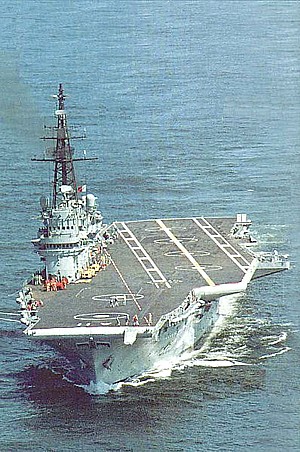 The pragmatic solution to this issue led to the introduction of the visually obvious angled flight deck and this offered multiple advantages. While the foredeck was used to store 'ready to launch' aircraft and fitted with steam driven catapults for launching, the angled flight deck was free for retrieval and landing. In worst-case scenarios of a bad landing, the plane might ditch to one side of the ship rather than threaten major damage to the ship and aircraft. It also afforded the opportunity for the pilot to abort landing and 'go round again' without risk to the launching aircraft.
The pragmatic solution to this issue led to the introduction of the visually obvious angled flight deck and this offered multiple advantages. While the foredeck was used to store 'ready to launch' aircraft and fitted with steam driven catapults for launching, the angled flight deck was free for retrieval and landing. In worst-case scenarios of a bad landing, the plane might ditch to one side of the ship rather than threaten major damage to the ship and aircraft. It also afforded the opportunity for the pilot to abort landing and 'go round again' without risk to the launching aircraft.
Not surprisingly, users of the 'Colossus' and 'Majestic' class carriers sought to substantially improve these vessels by having most the newer technologies retrofitted at a later date. Even within the Royal Navy, such modifications were applied to the already elderly HMS Victorious originally launched in 1939 and eventually scrapped in 1969.
Even when 'HMS Eagle' of the later 'Centaur' class was commissioned in 1951, it entered Royal Navy service without that feature but later upgraded to include one. Four years later when its sister ship, 'HMS Ark Royal' was commissioned in 1955; it was part of the standard design from the outset and the first of its type in the World. America's equivalent followed eight months later in the shape of the USS Forrestal.
Looking back then, the Canadian request was sane and reasonable and the Majestic Class aircraft carrier originally deemed, 'HMS Powerful' became 'HMCS Bonaventure' and named after an island in the St. Lawrence Seaway reserved for wildlife. The carrier carried McDonnell F2H-3 Banshee jet fighters and Grumman CF2F Tracker ASW aircraft plus Sirkorsky HO4s helicopters during its career. Despite this, landing on the 'Bonaventure' seems to have been a scary experience with some US pilots refusing to do so on account of its short deck and yet, it is recorded how the ship was capable of covering huge expanse of ocean via aerial patrols in 1958. Like the two Canadian owned carriers before her, 'HMCS Bonaventure' was based at Halifax, Novia Scotia and it became their last.
"The Bonnie" was decommissioned in 1970 and scrapped in 1971. Canada has never had an aircraft carrier since that time.
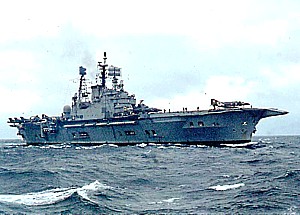 In some ways, there are parallels between that of Canada and Australia in respect of naval ownership of aircraft carriers. Like Canada, they had a Colossus class carrier for a period of time but then returned it in favour of a Majestic class carrier in building. While the returned craft became the 'NAe Minas Gerais' of Brazil, Australia was happy to accept 'HMS Terrible' under the new name of the 'HMAS Sydney' in 1948.
In some ways, there are parallels between that of Canada and Australia in respect of naval ownership of aircraft carriers. Like Canada, they had a Colossus class carrier for a period of time but then returned it in favour of a Majestic class carrier in building. While the returned craft became the 'NAe Minas Gerais' of Brazil, Australia was happy to accept 'HMS Terrible' under the new name of the 'HMAS Sydney' in 1948.
From late 1951 to early 1952, she operated off the coast of Korea during the Korean War and making her the only aircraft carrier in the Royal Australian Navy (RAN) to experience wartime service only to be assigned to training duties in 1955 and in advance of another Majestic class vessel christened as 'HMAS Melbourne' and assuming the identity of the final Majestic ship initially known as 'HMS Majestic'.
HMAS Sydney was placed in reserve in 1958 but recalled as a fast troop transport ship in 1962 in support of Malaysia's defence policy against Indonesia. In 1965, she sailed as a troop ship with equipment and supplies to Vuung Tàu, and earning the nickname of the 'Vuung Tàu Ferry' during the Vietnam War. 'HMAS Sydney' was decommissioned in 1973 and scrapped in 1975.
As regards 'HMAS Melbourne', many came to believe the ship was 'jinxed' in some fashion and especially when, in February 1964, the carrier collided with a 'Daring class' destroyer that had altered course across her bow. Eighty-two crewmen were killed. In June 1969, Melbourne collided with and sank the 'USS Frank E. Evans' with seventy-four fatal casualties. Essential replacement parts concerning the maintenance of the steam catapult were obtained from the 'HMCS Bonaventure' shortly before the latter was scrapped.
Melbourne was decommissioned in 1982 and a serious proposal to convert the vessel into a floating casino delayed the ultimate sale to a Korean Scrap Yard in 1985.
The notion of helicopters goes back centuries but the first practical design came from Russian designer Igor Sirkosky in 1940 and much too late to see much of active service in World War Two. In the immediate post war period though, his invention was quickly adopted to fulfil many roles, both in peacetime and as a new extension of military capability.
From a sea power military perspective, the advancement of helicopter technology has opened up a whole new chapter and where many of the wartime aircraft carriers found new life as assault ships or else in the role of antisubmarine warfare. In a ground support role, the fast moving 'gunship' whilst necessarily slower than a jet fighter, presents greater agility, accuracy and astounding firepower. New design proposals include all weather 'helo' variants of early warning aircraft akin to the 'Crows Nest' technology currently under consideration by the Royal Navy. If accepted for development and ultimately proven, 'Crows Nest' could mean colossal savings in terms of ship size and cost but, even if chosen for development, we're talking of an application at least a decade into the future.
Early warning of threats has always been related to height above the waves. The 'Crow Nest' of olden sailing ships added distance to a range of visual sight of about seven miles at sea level due to the curvature of the planet. Going higher and using radar extends this by a huge degree. In the Second World War, some U-Boats carried kites so that a man might be held aloft and report any potential dangers. Some submarines even carried powered aircraft but in modern times, one of the best maritime aircraft capable of this task is the Northrop-Grumman E2-Hawkeye with its distinctive rotating saucer shaped radome rising above the fuselage.
Inclusion of E2-Hawkeye capability was deemed vital when the French Navy ordered building of the currently serving nuclear powered 'Charles De Gaulle' then discovered that the deck was too short to allow this feature. With embarrassment and at great expense, the deck was extended to allow application and use of this aircraft.
Starting back in 1957, the British Hawker Siddeley Aircraft Company seriously addressed the notion of a jet aircraft with Vertical Take-Off and Landing (VTOL) characteristics akin to that of a helicopter. Test flights of the Kestrel prototypes took place in 1960 and three were lost in crashes but one did land and take-off from the deck of HMS Ark Royal in 1963.
In some quarters, it became known as the 'Jump Jet'.
Subsequent collaboration between the American McDonnell Douglas Company and British Aerospace resulted in the Harrier; perhaps the most successful aircraft design of its type ever created. With its powerful Rolls Royce Pegasus engine and vectored thrust nozzles, the Harrier in all variants may always remain as the most successful and pioneering Vertical/Short Take Off and Landing (STOVL) aircraft ever built. While the unique different versions for the Royal Air Force found favour in Britain and performed valiant service in the Falklands; many of the AV8 variants, originally conceived for use by the US Marines, found favour in Spain, Italy, Thailand and elsewhere.
By comparison, the Soviet Yaklov 36-38 'Forger' series used three engines and was distinctly unreliable in humid climes and most notably applied for use on the 'Kiev' class of ships often described accurately as 'aircraft cruisers' rather than aircraft carriers in the accepted sense. In practice, the aircraft were assigned to the 'Kiev' class 'aircraft cruisers' became known among Russian sailor slang as 'peace doves' or 'foremast defence aircraft'. In use, and just ahead of the USSR dissolution, all Yaklov VTOL aircraft were returned to land based duty.
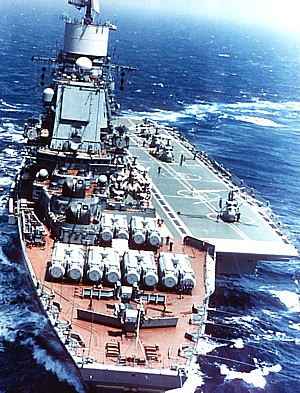 As the USSR faded into history, the entire future of the 'Kiev' class ships fell under the careful eye of post 'Cold War' economics and where the budget could not include small deck 'aircraft carriers' of that type. At around 43,000 tons per copy, the four 'Kiev' class vessels had been designed foremost as warships in which the bow area bristled with missiles while the stern offered an angled flight deck for aircraft. In the wake of the USSR break-up, all four ships became the preserve of the Russian Navy.
As the USSR faded into history, the entire future of the 'Kiev' class ships fell under the careful eye of post 'Cold War' economics and where the budget could not include small deck 'aircraft carriers' of that type. At around 43,000 tons per copy, the four 'Kiev' class vessels had been designed foremost as warships in which the bow area bristled with missiles while the stern offered an angled flight deck for aircraft. In the wake of the USSR break-up, all four ships became the preserve of the Russian Navy.
One was quickly despatched to a Korean shipyard for scrapping while another two were sold to China in a strange deal where establishment of offshore casinos at Tiangin and Shenzhen appeared to be the primary motivation. Conditions of sale included that the ships would never be rearmed for military purposes and the Chinese abided by these stipulations.
That left one ship of the class to be sold and where, under Soviet Control, it had been named 'Baku' but after dissolution of the USSR, it was unacceptable to have a ship named after the capital city of an independent state namely that of Azerbaijan. The ship was hastily renamed as the 'Admiral Gorshkov' then served under that name. A few years later, in the late 1990s, the ship suffered a major engine room fire and which confined it to port for years afterward. In 2004, the Indian government purchased the ship and work to convert it into a 'proper aircraft carrier' began with an anticipated delivery from the Russian Sevmash Shipyard in 2008. Somwwhat overdue and now costing $2.2 billion rather the orginal estimate of $974 million, the 'INS Vikramaditya' ('Brave as the Sun') was commissioned int othe Indian Navy on 16th November 2013. I've included two photographs here with the upper showing how the ship looked when known as 'Baku' and how it looks in current times. As you can see, the difference is startling and where the newly refitted ship operates in a Short Take-Off But Arrested Recovery Mode (STOBAR) mode using Russian built MIG-29k aircraft.
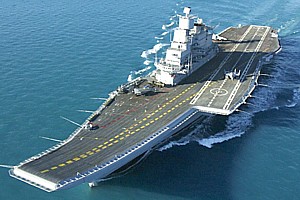 By far, this represents the largest export order for the aircraft type with ramifications within the Russian military aircraft industry. Until now, the Russian Navy has preferred Sukhoi models but they too have placed orders for the MIG-29k largely upon economic grounds of scale. As such, the MIG-29k will become the mainstay of the Indian and Russian Fleet Air Arms well into the twenty first century.
By far, this represents the largest export order for the aircraft type with ramifications within the Russian military aircraft industry. Until now, the Russian Navy has preferred Sukhoi models but they too have placed orders for the MIG-29k largely upon economic grounds of scale. As such, the MIG-29k will become the mainstay of the Indian and Russian Fleet Air Arms well into the twenty first century.
In the meantime, India's current operating aircraft carrier is the 'INS Viraat' and which is the former 'HMS Hermes' best remembered as the flagship of British Naval Forces during the Falkland Isles conflict of 1992 (See Below). It is expected that the 'INS Viraat' will continue to serve until at least 2015 but more likely for longer if possible. As before and in Royal navy service, it employs the same techniques and Harrier aircraft in a Short Take Off and Vertical Landing (STOVL) mode.
Currently, India has two new indigenously designed aircraft carriers (IACs) in building and where a huge proportion of the materials, including the high-grade steel used in their construction, has been sourced within India. Begun in 2009, the first 262 metre (860ft) long hull was launched in 2013 and will be commissioned as the 'INS Vikrant' in 2018. The second 40,000-ton aircraft carrier of similar design is expected to enter service just two years later inder the name of Vishal. Akin to the 'INS Vikramaditya', the new carriers will operate MIG-29K aircraft in STOBAR mode.
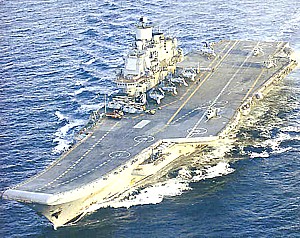 In the closing era of the Soviet Union, it was clear that the Kiev class of 'aircraft cruisers' were insufficient to meet the defence objectives planned for them and where a wholly dedicated aircraft carrier design was needed to replace them. Starting in 1982, two ships were laid down at the Chernomosky Shipyards in the Black Sea and building work started.
In the closing era of the Soviet Union, it was clear that the Kiev class of 'aircraft cruisers' were insufficient to meet the defence objectives planned for them and where a wholly dedicated aircraft carrier design was needed to replace them. Starting in 1982, two ships were laid down at the Chernomosky Shipyards in the Black Sea and building work started.
As previously indicated, faith in the Yakovlev VTOL fighter had faded. The Russian Navy far preferred the new high performance generation of aircraft designed and built by Sukhoi with the Su-27 and later models being especially favoured. This implied introduction of newer and larger aircraft carriers more akin to that employed by the United States but by the time of the USSR dissolution, neither of the two ships was complete.
By 1990, and where the break-up of the USSR seemed imminent, one ship was fairly close to completion while the other lagged far behind. In haste, the more complete ship was towed out from the Chernomosky Shipyards into the Black Sea and thence through the very difficult and treacherous Bosphorus before emerging into the Mediterranean Sea.
This was a major and hazardous undertaking by any standard since the Bosphorus handles about seven times more traffic than the Suez Canal and three times more than the Panama Canal. It's a notoriously difficult passage for any ship where many complicated and precise turns are needed - and definitely worse if the vessel is being towed! Ultimately, it was safely delivered into a port within Russian borders for final fitting out.
Originally christened as 'Riga' and launched as the 'Leonid Brezhnev' then renamed as 'Tbilisi' during sea trials, the fully completed Russian aircraft carrier assumed the flagship role under the name 'Admiral Kuznetsov' and with a Fleet Air Arm currently comprising Sukhoi jet aircraft operating in the STOBAR configuration as described above in circa 1991.
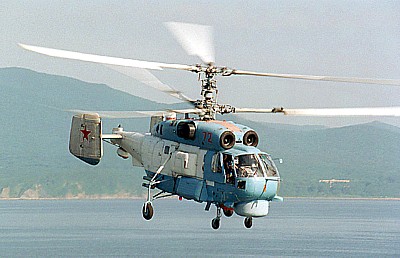 It is arguably the largest aircraft carrier in the European region at present and is equipped with Sukhoi 33 fighter aircraft, Kamov helicopters with their distinctive contra-rotating wings and several other specialist aircraft. Unusually by western standards, the vessel is equipped with Surface to Air Missiles (SAM) and Anti-Submarine munitions too and thus akin to the multiple role of the 'aircraft cruiser' concept of the 'Kiev' class but with far more emphasis on the aerial capability of its Fleet Air Arm.
It is arguably the largest aircraft carrier in the European region at present and is equipped with Sukhoi 33 fighter aircraft, Kamov helicopters with their distinctive contra-rotating wings and several other specialist aircraft. Unusually by western standards, the vessel is equipped with Surface to Air Missiles (SAM) and Anti-Submarine munitions too and thus akin to the multiple role of the 'aircraft cruiser' concept of the 'Kiev' class but with far more emphasis on the aerial capability of its Fleet Air Arm.
So far as is known, there are major plans to refit the 'Admiral Kuznetzov' in the near future with some western news agencies touting conversion to nuclear powered engines as a distinct possibility. Some of these agencies also promoted the superior performance of the 'Foxbat' jet fighter and numerical supremacy of the 'Backfire' bomber during the Cold War!" Whilst not entirely implausible; the 'Kuznetsov' would be out of service for an extended period of time and without another to carry the load during that refit.
More probable is removal of some missile systems to make way for more aircraft but this time of the MIG-29k variety and in conjunction with those ordered by the Indian Navy as described above. Combining the two major orders means the unit cost of each aircraft is dramatically reduced for both of the principal buyers.
In 2013, the 'Admiral Kuznetsov' carries fourteen Sukhoi 33 aircraft but in the proposed refit, the vessel will carry double that number of MIG-29k fighters. The refit will also include major modernisation of electronic systems and more.
So what of the second ship begun in 1980, couldn't that be a solution?
Well, it might have been in the past but on Christmas Day 1991, the USSR effectively ceased to be and by midnight of Boxing Day, the 'Commonwealth of Independent States' replaced it.
Whatever remained within a state boundary became the property of that new government and that included the hull of the second aircraft carrier still partially built at Chernomosky Shipyards in the Black Sea. According to some sources, a variant Sukhoi jet fighter aircraft was crucially left behind too. The independent state of Ukraine acquired ownership of both by default.
Although technically complete in terms of the hull structure, there was little else beyond that. The Ukrainian government sought to raise revenue by selling it at auction and where a small Chinese company based in Hong Kong was declared as the winner.
According to their published prospectus, the ship was destined to become another offshore casino and in much the same way as the former Russian cruisers 'Kiev' and 'Minsk' had been used but on this occasion, the sellers were not Russian and previous agreement did not apply.
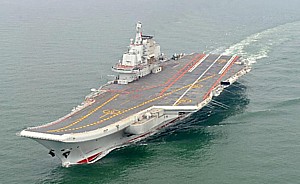 The planned future of the hull named 'Varyag' was supposed to be that of a new and larger offshore casino located near Macao but even before the auction began, authorities on the Isle of Macao publicly refused permission for the project to proceed - not that it actually mattered because the stated plan was that of fantasy. It seems there was never was such intent!
The planned future of the hull named 'Varyag' was supposed to be that of a new and larger offshore casino located near Macao but even before the auction began, authorities on the Isle of Macao publicly refused permission for the project to proceed - not that it actually mattered because the stated plan was that of fantasy. It seems there was never was such intent!
What followed was intense debate about whether the hull should be allowed to risk the treacherous waters of the Bosphorus and despite similar risks that had been present when the 'Admiral Kuznetsov' had been taken through the very same channels and waters. In late 2001, Turkish authorities finally gave their consent and Dutch salvage tugs conducted much of the work needed to move the hull into the Mediterranean Sea.
The normal passage for ship through the Bosphorus takes ninety minutes of adrenalin and fear. Moving the 'Varyag' took more than six hours! Shortly after leaving the Bosphorus, all towlines to the ship was lost and the whole venture came close to calamity. Restoration of control was achieved despite high winds.
Even today, the Egyptian Overseers of the Suez Canal do not permit 'dead ships' to enter or leave without proven independence of their own power to do so. 'Varyag' was thus excluded of this short cut and where the tow meant an extended voyage around the Cape of Good Hope to circumnavigate Africa and thence towards it's eventual dock in the Dalian shipyard located in the North-East Chinese province of Liaoning. It had cost the equivalent of about $30 million for the acquisition including the entire expenses combined and yet still far less than any fresh build aircraft carrier development program. On 25th November, 2012, the 'People's Liberation Army Navy (PLAN) of China accepted their first aircraft carrier into service and where five Shenyang J-15 aircraft were successfully landed and launched from its deck. This is the Chinese variant of the Sukhoi 33 aircraft sold to them by the government of Ukraine and in June 2013; pilot training began with major participation from the Brazilian Navy.
At present, China seems happy to observe the 'Liaoning' as a training ship for the future. Like their 'Chindian' counterpart India, (a phrase most famously advocated by Chinese economist and politician Deng Xiaoping but actually innovated by the Indian politician Jairam Ramesh), China has recognised how so much of its continued expansion is reliant upon raw materials and political goodwill from abroad. It is competitive and akin to the US position of the past when the British Empire was considered as threatening to US interests. China and India are also geographically proximate and both are regarded as thriving economic powerhouses of the future with the highest potential growth for the next fifty years!
Taken together, one-third of the global population is now Indian or Chinese.
Since the 'Liaoning' entered service, there have been various rumours about a Chinese intent to build indigenous aircraft carriers but it remains uncertain whether any construction work has even begun in this direction.
As described above, it can be realised that most British aircraft carriers actually were in build by the time of Second World War. The last of these was 'HMS Ark Royal (Pennant: R09)' and which was an Audacious class ship first laid down in 1943 as 'HMS Irresistible'. The name was changed before it's launching in 1950 since a previous ship of the same name had been torpedoed and sunk during the war. Originally, four Audacious class ships were ordered but two were immediately cancelled when the war ended. Of the two remaining sister ships, 'HMS Eagle' entered service too quickly to have an angled flight deck fitted from the outset but this feature was added during a refit much later.
Although deemed as a 'sister' ship to the Ark Royal, 'HMS Eagle' had the more illustrious career and served during the Suez Crisis while 'HMS Ark Royal' did not. Neither were ever fully engaged in a truly wartime setting and both spent significant periods of time in dock while receiving refits, modernisation and improvements. Eagle's air group composition was 12 Sea Vixen, 14 Buccaneers, and 4 Gannet's with three AEW3 variants, 6 Sea King Helicopters for Antisubmarine Warfare and 2 Wessex Search and Rescue helicopters. Ultimately, it was the colossal cost of maintenance that sealed the fate of both ships. In the case of Ark Royal, and over a period of 23 years, the ship had actually spent eleven years on active duty at sea and thence in dock for twelve years while undergoing a virtually constant stream of modernisation and refits. Something had to give way to satisfy the National Treasury and the 1966 decision to severely curtail the Royal Navy fixed wing carrier fleet in favour of smaller ships capable of using the newly developed and modern yet still unproven Short Take-Off and Vertical Landing (STOVL) technology found great favour. Some even imagined a concept whereby the Harrier aircraft might be launched from the decks of merchant ships in a crisis and where, during war, such ships could be quickly translated into warships by loading converted 'freight containers' specially fitted out with varying content ranging from missile launchers to command and control centres. Many years later, such bizarre concepts seem akin to the animated puppet children's fantasy of 'Thunderbirds' and yet might prove feasible. In World War 2, few would have thought about large merchant ships being fitted with flight decks and carrying defensive fighter aircraft!
In practical terms, it saw the British government favour smaller ships like 'HMS Hermes' and which was launched and introduced into service around a similar period of time. Hermes had been reduced to the role of 'helicopter carrier' in 1971 but then found new life as the Harrier aircraft became elevated into the role of the primary strike aircraft of the Royal Navy. Not only that but the useful invention of the 'ski jump' latterly fitted to HMS Hermes afforded credibility that smaller aircraft carriers could perform any task just as well as the much larger ships. In 1972, 'HMS Eagle' was decommissioned then towed to a quiet part of an estuary while listed as in reserve but already stripped of vital machinery and refitted aboard 'HMS Ark Royal'. Six years later, 'HMS Eagle' was towed to Scotland for scrapping in order to clear the same berth for 'HMS Ark Royal' and which occupied the same spot a few weeks later. 'HMS Ark Royal' was scrapped two years later and it marked the end of conventional fixed wing aircraft use by the Royal Navy, an important status that has never been attained ever since.
'The Mighty Ark' took five years to fit out completely after launching and was commissioned into British service in 1955. At over 50,000 tons full load, the 'HMS Ark Royal (R09)' remains as the largest ever aircraft carrier to have been in service with the Royal Navy.
Throughout her twenty-nine year career, 'HMS Ark Royal' carried many different aircraft but the ensemble between 1970 to 1978 included 12 Buccaneer aircraft and with an ability to act as in flight refuelling aircraft via external pods. There were 14 Phantom FG1 and 4 Gannets; three of which were AEW3 (early warning variants), 7 Sea King helicopters in the role of ASW (Anti-Submarine Warfare) and 2 Westland Wessex helicopters for Search and Rescue. When the name of 'HMS Ark Royal' was applied again; the third ship of the 'Invincible' class would be modern but of far lesser capability and constructed on a premise of economics rather than pragmatic sense. Given the 'political football antics' of the period, it's a blessed miracle that it ever got built at all!
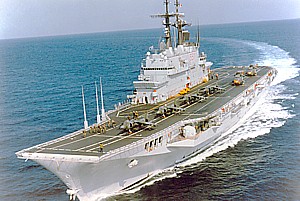 British considerations during the early 1970s for aircraft carriers were theoretically considered and where two aircraft carriers named 'Queen Elizabeth' and 'Duke of Edinburgh' never went beyond the planning stages. Later in that decade, the notion of a 'compact aircraft carrier' entirely dependant upon Short Take Off and Vertical Landing (STOVL) capability of the Harrier aircraft found favour among many nations. The combination of McDonnell-Douglas of the USA and British Aerospace seemed like a marriage made in heaven. The AV-8 variant was what the US Marine Corps wanted and the GR.8 and GR.9 variants fitted UK interests too. Beyond local shores, several countries also expressed major interest and planned accordingly.
British considerations during the early 1970s for aircraft carriers were theoretically considered and where two aircraft carriers named 'Queen Elizabeth' and 'Duke of Edinburgh' never went beyond the planning stages. Later in that decade, the notion of a 'compact aircraft carrier' entirely dependant upon Short Take Off and Vertical Landing (STOVL) capability of the Harrier aircraft found favour among many nations. The combination of McDonnell-Douglas of the USA and British Aerospace seemed like a marriage made in heaven. The AV-8 variant was what the US Marine Corps wanted and the GR.8 and GR.9 variants fitted UK interests too. Beyond local shores, several countries also expressed major interest and planned accordingly.
The Italian experience was maybe harder than most and largely due to its former Axis political stance during World War Two yet by 1980, Italy was able to introduce their newest ship, the 'Giuseppe Garibaldi' (Pennant: 551)' to the World and where the BAe/Thanes design is self evident for use by STOVL AV-8 Harrier aircraft and helicopters. Already in its career, it has supported operations in Afghanistan, the Balkans and most notably in Libya. More recently, the Italian 'Marina Militaire' has commissioned the 'Conte di Cavour'; a 30,000 ton assault ship with a draught too deep to be based at the military harbour of Taranto. Strictly speaking, it's not an aircraft carrier in the conventional sense yet of a type finding greater credence among many European nations and elsewhere. Both are in service at this time of writing in 2013.
Spain has always had a long seafaring tradition and its association with Military aircraft at sea goes back to the seaplane tender Dédalo in the 1920s. Spain's first aircraft carrier of wartime vintage initially seeing service in the US Navy as the USS Cabot in the late 1940s and was initially loaned from the United States in 1967 and purchased outright in 1972.
It was also named Dédalo and given a major refit in 1975.
One of the problems facing modern use of the carrier concerned the wooden deck typically fitted to US carriers during the wartime era. It was decided to use Harrier VTOL jets as the principal aircraft on board but the vectored thrust of the Harriers would have destroyed the deck. As a consequence, the aft deck was overlain with a protective metal skin. Unlike other carriers adopting the Harrier, Dédalo was never fitted with a bow 'ski jump' ramp and this absence limited the weapons load capability of her aircraft.
Overall, her career was fairly uneventful and after travelling 300,000 miles over 1650 days during her service with the Spanish Navy, the ship was decommissioned in 1989 and offered to a US organisation who planned to use it as a museum. Unfortunately, the organisation in question was unable to raise sufficient monies or pay their creditors resulting in an auction in which the bid by Sabe Marine Salvage was successful. The ship was scrapped in 2002.
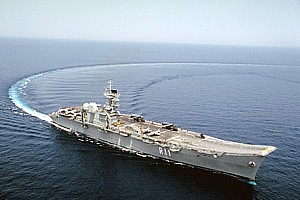 Spain's next aircraft carrier was based on the US Sea Control Ship concept of the US Navy proposed in the 1970s but redesigned with the AV-8 Harrier in mind and built in Spain. At less than 17,000 tons full load, the 'Principe de Asturias' could support 29 aircraft with 17 below in its hanger. The typical Air Arm comprised 12 Harriers and Sikorsky Sea King helicopters including airborne early warning and antisubmarine warfare variants.
Spain's next aircraft carrier was based on the US Sea Control Ship concept of the US Navy proposed in the 1970s but redesigned with the AV-8 Harrier in mind and built in Spain. At less than 17,000 tons full load, the 'Principe de Asturias' could support 29 aircraft with 17 below in its hanger. The typical Air Arm comprised 12 Harriers and Sikorsky Sea King helicopters including airborne early warning and antisubmarine warfare variants.
The ship was awarded flagship status and assigned to the Alpha group comprising a fleet of six Santa Maria class frigates (Spanish variant of the US Oliver Hazard Perry class) and where support vessels were assigned as required. From 2008 until current times, the Spanish economy has contracted on a massive scale and in 2012, the expenditures concerning the 'Principe de Asturias' were reviewed and in light of the Armada Espanola having received the newer multi-purpose assault ship, 'Juan Carlos I' in 2010.
The 'Juan Carlos I' is named after Spain's reigning monarch and is designed to be more than an aircraft carrier and akin to the US Wasp class LHDs with an ability to transport troops and their equipment to foreign shores and provide aerial support as needed. It's another example of how contracted economies of some nations are less able to afford aircraft carriers as separate entities and where the trend in likely to continue in the foreseeable future. The 'Principe de Asturias' was decommissioned in February 2013 but remains in that state at present with final decisions as regards its future still to be taken. It's sister ship, the 'HTMS Chakri Narubet' of the Royal Thai Navy (RTN) has fared better but that assessment does not equally apply to that of its aircraft.
Built in Spain and to similar specifications as the 'Principe de Asturias', this aircraft carrier was delivered and commissioned into the Thai Navy in 1997. As part of the deal, early versions of Harrier aircraft were embarked after refurbishment but few were maintained to sufficient level and this capability has largely evaporated in current years. For the most part, the vessel has been in port at Sattahip with singular one-day excursions on roughly a monthly basis allegedly for training purposes and sometimes with members of the Royal Family aboard. Naturally, this has led to media allegations of the ship being used as an oversized 'Royal Yacht' but this is tempered by its welcome and useful application in the wake of several Search and Rescue operations following major geological disasters that occurred in the area in 2004 and 2010. It remains operational at this time of writing in 2013.
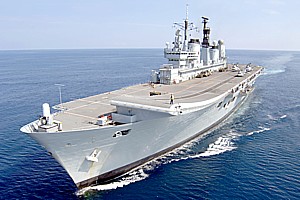 It's pretty fair to say that most British aircraft carriers were overthrown models of the optimistic planning begun back in 1942 and where projections of need were based on the continued existence of the British Empire in the post war period but by 1949, the British Empire ceased to exist and the newer Commonwealth came into being. It was also the year in which a small group of European governments previously cementing a localised policy of mutual defence in 1948 were suddenly joined by many more nations on both sides of the Atlantic Ocean and to become the core of the North Atlantic Treaty Organisation (NATO) in 1949.
It's pretty fair to say that most British aircraft carriers were overthrown models of the optimistic planning begun back in 1942 and where projections of need were based on the continued existence of the British Empire in the post war period but by 1949, the British Empire ceased to exist and the newer Commonwealth came into being. It was also the year in which a small group of European governments previously cementing a localised policy of mutual defence in 1948 were suddenly joined by many more nations on both sides of the Atlantic Ocean and to become the core of the North Atlantic Treaty Organisation (NATO) in 1949.
At the heart of this organisation of mutual defence was a fear that the Union of Soviet Socialist Republics (USSR) might invade a severely weakened Europe or else more secretly advance the cause of communist ideals. It became a war in which there was no major battles fought in over forty years but in which thousands were slain during the 'Cold War'.
The Isle of Britain became regarded as the 'unsinkable aircraft carrier' and where many troops and aviators of NATO Allies arrived to supplement local armed forces. British armed forces served in bases located in Germany and where the new 'front line' was formed. German entry in NATO prompted the counter-establishment of the 'Warsaw Pact' in 1955.
In the late 1960s and 1970s, it was proposed that two new aircraft carriers should be built to replace the ageing carriers of that period and where they would be called 'Queen Elizabeth' and 'Duke of Edinburgh' but the CVA program never went beyond the drawing boards. Neither of the ships was built on the grounds of economic stringency.
In a very different Word that had existed just a few decades beforehand; the need for large fleet aircraft carriers seemed to have diminished and where, if war should come again to these shores, then the essential and crucial need to retain trans-Atlantic trade was paramount and in the same way as during World War 2. Then as now, Britain is a huge importer of goods and where the maritime trade to service this import equates to 2% of the British economy in 2013.
It thus made sense to invest in a new form of Harrier based 'escort carrier' and to ensure they were ready to operate in such times of threat. Under a Labour government already committed to high investment of oil discovery and exploitation in the North Sea, three 'through deck cruisers' were ordered for construction in 1973 with the first being 'HMS Invincible' due into service in 1978 but actually commissioned in 1980.
In terms of operation, Harrier aircraft were launched by rolling along the deck and then onto a 'ski jump' at the bow of the ship. To land, the Harriers would hover to one side and then slip sideways until over the deck before the pilot made a careful judgement as regards the pitch and roll of the deck before committing himself and his plane to a vertical descent. Such was and is the skill of such pilots that no plane was ever lost to crash landing.
The Conservative government with Prime Minister Margaret Thatcher came to power in 1979 and just in time to enjoy the fruits of previous administration investments in North Sea Oil and the recent aircraft carrier building program. Within months of being elected, her government openly decreed that the newly built 'HMS Invincible' was superfluous to UK requirements and rashly promised the vessel for sale to Australia. It was a sale transaction never to be enacted as the Falkland Isles Crisis began just a few weeks later.
On Friday, 2nd April 1982, Argentine forces invaded and occupied the Falkland Isles and South Georgia in pursuit of a long-held claim of sovereignty lasting many years. In response and after diplomatic channels had been exhausted, British armed forces were charged with the mission of relieving the islanders from occupation by means of a sea borne invasion.
Neither side officially declared war so hostilities were confined to the islands in question. At an early stage, Britain declared a 'military exclusion zone' around the islands and attempted long-range bomber missions using Vulcan bombers and a fleet of in-flight refuelling Victor tankers with a starting and ending point in the distant Ascension Isles.
It proved risky and dangerous - incredibly so and very nearly ended in disaster! Although the damage done to the airstrip at Port Stanley was modest, the 'shock and awe' experience of a British bomber aircraft over Port Stanley so soon after Argentine arrival must have given the clearest message of intent to the Argentine 'Junta' government and who had miscalculated the level of response.
Although still popularly regarded as a 'blue water' navy, the Royal Navy had been steadily reducing in size over many years and where the number of principal ships had been reduced to about four dozen or less. The frigate, HMS Fife, was in refit during the conflict and thus excluded from the hastily assembled fleet.
Participation involved all three military services and Territorial Army Units were called up to provide transportation of arms to the docks for loading into the ships. Harriers in service with the Royal Air Force were placed aboard the flagship HMS Hermes and aboard the newly commissioned HMS Invincible. Truth be told, neither ship was sufficiently large enough to be considered as fleet aircraft carriers yet they were assigned into that role. At best, the two carriers could launch about two-dozen Harrier aircraft with RAF variants given attack roles and while the remainder protected the fleet as best they could. Both ships could launch about the same number of helicopters in Anti-Submarine operations but there was one crucial aspect missing from the fleet even as it began to assemble.
The distinct lack of airborne early warning aircraft proved to a major and costly absence for the British fleet. The two carriers were far too small to permit inclusion of an E2 Hawkeye Air Early Warning (AEW) aircraft or anything similar. Belatedly, Wessex helicopters were fitted out with a Heath-Robinson kind of apparatus involving an inflated radome attached to one side of the fuselage. When landed, the radar assembly was tilted a full ninety degrees and in line with the fuselage. In flight, it was rotated downward and permitting a full 360-degree view of the locality beneath the body of the aircraft. In current times, this radar technology has been massively improved and is currently fitted to the Sea King SH-3 AEW variant and in service with many nations.
Ultimately, the British Armada comprised 127 ships of which 43 were Royal Navy warships with 22 Royal Fleet Auxiliaries in convoy with 62 merchant ships. At the heart of this great venture were just two rather small aircraft carriers of relatively modest capability. A larger fleet carrier with more aircraft might have been better able to defend merchant components of the fleet at a distance from each carrier.
The tragic story of the 'SS Atlantic Conveyor' is a case in point. Having been requisitioned by the British Ministry of Defence from Cunard, the ship was loaded with ammunition, fuel and essential supplies before heading for the Ascension Isles. Here, the ship received a cargo of twelve RAF Harriers before heading south towards the Falkland Isles. It arrived in the 'war zone' in mid-May and where the Harrier aircraft were quickly transferred to the carriers.
On 25th May, two Argentine pilots flying Dassault Super Étendard aircraft spotted the merchant ship and wrongly concluded that it must be one of the British aircraft carriers on account of its size. Both launched AIM-39 Exocet missiles at the ship and where it's alleged that at least one missile malfunctioned and failed to detonate its warhead but spilled its remaining fuel and then started a major fire. Twelve sailors aboard the 'SS Atlantic Conveyor' were killed including the well renowned mariner, Captain Ian North, who was posthumously awarded the Distinguished Service Cross. Although best efforts were made to save and tow the ship to safety, it sank on the 28th May and taking virtually all of the army Chinook helicopters with it. 'Atlantic Conveyer' became the first merchant ship lost to enemy action since World War Two!
On that same day, 25th May, HMS Coventry and HMS Broadsword were operating together in 'Type 64' mode (Coventry was a Type 22 frigate. Broadsword was a Type 44 frigate) and where the joint use of their differing weapon systems could prove highly effective whilst distracting attention away from the troop landing operations in San Carlos Bay. They were positioned North-West of Falkland Sound and initially, it seemed ruse worked better than expected and where both ships came under attack from Argentine bomber aircraft.
Being close to land rather than in open sea presented technical problems for some of the missile weapon systems and this became all too apparent during this particular mission. More than once, neither ship could 'lock on' to their intended targets and where even a machine gun jammed at a crucial point in time. HMS Broadsword was the more fortunate of the pairing. One bomb struck the ship after bouncing on the surface of the ocean and then proceeded to progress through the hull without detonation. In sharp contrast, HMS Coventry was doomed in a matter of seconds. Three bombs hit it; one of which did not explode. One destroyed the computer room and associated control centre and incapacitated most senior officers of the crew. The second bomb ruptured the bulkhead between the engine rooms and thus permitted flooding to the largest areas of the ship. Coventry capsized twenty minutes later then sank soon afterward. Broadsword rescued 170 personnel including 30 injured and leaving 19 to be unaccounted for. It is alleged that Coventry's crew collectively sang the satirical song, "Always Look On The Bright Side of Life" from the Monty Python Film, 'Life of Brian' while they awaited rescue. On the next day, one of Coventry's injured, Paul Mills, died.
On that same day, a bomb launched from Argentine aircraft hit 'HMS Antelope' and crashed through several decks before becoming lodged within the hull. Professional attempts to defuse the bomb failed and 'HMS Antelope' became another casualty of war.
Even the 'Iron Lady' Margaret Thatcher is allegedly reported as uttering doubt at this stage of the war and allegedly saying, "Just how much more of this can they take?"
In this author's view, she was right to be concerned at that stage. British arms merchants had courted Argentina as a potential market for many years and where sales of British ships and new technology had been regarded as a regular form of business. By this means and during the 'Falklands War', Argentine pilots knew how to 'peck the lobes' of British radar systems and 'get in close' before launching their attacks. The only thing they couldn't effectively counter was how British Harrier pilots had learned how to use the vectored thrust technology of the Harrier to turn more tightly inside the turning arc of the regular jet aircraft pitted against them. Throughout the conflict, only one Harrier was hit by enemy fire and the damage was minor.
Taking the British Naval Fleet into San Carlos water between the two islands was always likely to invite risk and it could have been much worse since the Argentine air force use of 'retarded bombs' dropped from low altitudes meant that several bombs did not have sufficient time to arm before hitting their targets.
By way of a brief and simplistic description, 'retarded bomb arming mechanisms' of the period typically meant a system in which the bomb was carried by the aircraft in a 'safe mode' during regular flight and handling. As a crude explanation of this system, the bomb cannot become active or armed until two essential components are joined together or else an electrical switch can be activated yet both systems providing a vital delay before explosion and in which time, the bomber aircraft might still be overhead and subject to damage and destruction.
Retarded bombs of the period typically avoided this scenario by having a small propeller built into the tail assembly of the bomb and which is locked in place during regular flight. Upon release, however, the small propeller is allowed to spin and unscrew the arming mechanism. This takes several seconds depending upon the settings and permits the bombing aircraft to be safe and away from the impending explosion. More than once then, Argentine pilots flew so low that the 'retarded bomb arming mechanisms' had insufficient time to arm the bomb before hitting the target and explains why losses to the British fleet weren't far worse!
In response to the advance of a British Armada far from home, Argentina ordered the former USS Phoenix now renamed as the 'ARA General Belgrano' on a course south of the Falkland Isles. At the same time, the aircraft carrier 'ARA Veinticinco de Mayo' mentioned earlier in this text was sent northward as part of a 'pincer movement' to intercept the British fleet. The first aircraft carrier battle since World War Two seemed inevitable but although the Argentine aircraft carrier detected the British fleet via tracking aircraft, the small aircraft carrier required a favourable wind in order to safely launch the heavily laden A4 jet fighters and this crucial element was absent on that day.
Unbeknown to them, the submarine 'HMS Spartan' had been assigned the task of locating the Argentine aircraft carrier but failed to find it. Another British submarine, 'HMS Conqueror', found the 'ARA General Belgrano' and was given permission to attack.
Conventional rather than high-tech torpedoes were employed and the controversial loss of the 'Belgrano' consumed the greatest portion of all lives lost in the brief war. In the wake of such loss, the 'ARA Veinticinco de Mayo' was hastily recalled to port and her air group redeployed to land bases. Argentine public mood had swayed greatly against the ruling government in view of these recent events and it's likely that another disaster concerning the potential loss of the aircraft carrier dictated their decision to withdraw it. The Argentine carrier played no further part in the conflict.
The Falklands War lasted for 74 days and ended with Argentine surrender on 14th June 1982.
During the conflict, 649 Argentine military personnel, 255 British military personnel and three Falkland islanders had died. In reality, it was a closely won victory with British forces facing major ammunition and supply shortages during the final hours. Following the loss of the 'Atlantic Conveyor', infantrymen of the British Army had been compelled to carry whatever arms and supplies they could over rough terrain and secure the 'high grounds' of Mount Tumbledown and neighbouring hills close to Port Stanley.
Shortly after the war was over, building work on 'HMS Illustrious' was advanced by ninety days and the second vessel of the small aircraft carrier series was able to head for the Falklands to relieve 'HMS Invincible'.
Within a year of the conflict, in 1983, the 'ARA Veinticinco de Mayo' was refitted to include the Dassault Super Étendard aircraft within its air group and presumably with plans to purchase more Exocet missiles. Unfortunately for them, the aircraft carrier endured engine problems soon after and became confined to port by 1990. As before and while the ship had been under former Dutch ownership, finding the necessary replacement parts had prompted reliance upon British assistance. In Argentina's case, this was not a valid option.
In 1995, the Italian shipbuilder Fincantieri was invited to inspect the 'ARA Veinticinco de Mayo' and assess the costs of restoration to service but the figure was prohibitive to the Treasury and in 1997, the 'ARA Veinticinco de Mayo' was officially decommissioned from service with no replacement in waiting. The ship was retained in port for some time afterwards as a source of spare parts for the Brazilian aircraft carrier 'Minos Gerais' before being towed to Alang in India for scrapping in the year 2000. Argentina hasn't replaced the ship at this time of writing and perhaps never will.
In Britain, Margaret Thatcher's government hastily revised their former assessment and the conditions of sale regarding 'HMS Invincible' to Australia. Suddenly, the elderly 'HMS Hermes' was offered instead and the Australian government rejected it while citing several issues about that decision. It was eventually sold the to the Indian Navy and where it continues to serve as the 'INS Viraat' and flagship of the Indian Navy in present times. HMS Invincible went on to serve in the Yugoslav Wars and Second Iraq War. The ship was decommissioned in 2005 and sold for scrapping to a Turkish Yard in 2011 albeit minus several major components for use by her sister ships.
Political relations between the United Kingdom and Argentina were restored in 1989 following a meeting in Madrid. Despite this, neither government had shifted their stance as regards the islands and publicly agreed to differ on the subject.
In the immediate wake of the conflict, the military 'Junta' government of Argentina was swept from power and where a plethora of internal issues came to light. The reformed Argentine constitution of 1994 included repetition of their claim to the Falklands and where the topic is still regularly discussed in Argentina. There is peaceful stalemate in the South Atlantic. Long may it continue!
Former World War One German pilot Hermann Goring pilot once asked his air commanders to request whatever they needed to win the 'Battle of Britain'. Werner Molders suggested more powerful engines for the Bf-109 while Adolf Galland famously suggested "a squadron of Spitfires!"
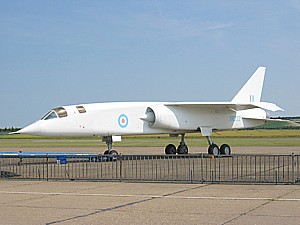 In 1957, British aircraft designers began work on a new advanced multi-role fighter aircraft and which proved to be many years ahead of its time. Major US military aircraft companies were keenly aware of the TSR-2 and feared how the innovative British aircraft would threaten their offshore sales. To get around this, US aircraft companies offered the British government a series of deals they could not ignore and where the cost of the TSR-2 project was ultimately deemed as excessive by comparison. Consequently, the TSR-2 project was cancelled on economic grounds although test flights provided highly promising results.
In 1957, British aircraft designers began work on a new advanced multi-role fighter aircraft and which proved to be many years ahead of its time. Major US military aircraft companies were keenly aware of the TSR-2 and feared how the innovative British aircraft would threaten their offshore sales. To get around this, US aircraft companies offered the British government a series of deals they could not ignore and where the cost of the TSR-2 project was ultimately deemed as excessive by comparison. Consequently, the TSR-2 project was cancelled on economic grounds although test flights provided highly promising results.
Sir Sydney Camm, designer of the Hurricane fighter aircraft that had helped save Britain from Nazi invasion observed, "All modern aircraft have four dimensions: span, length, height and politics. TSR-2 simply got the first three right!" In the wake of this decision, the Royal Air Force flew Lightning and Phantom aircraft designed and built in America.
It would be decades before the Royal Air Force received their first batch of multi-role Pan Avia Tornadoes built elsewhere at less cost than offerings from the USA and with differing mission intent.
Perhaps one of the best examples of this concerns a weapon system known as JP233 and is a 'runway use denial' projection in which a pod spills out 'bean cans' of mixed munitions onto a runway with some falling rapidly to ground and cratering the airstrip while others parachute onto the surface and then automatically become live mines to threaten anyone seeking to repair the air strip! The specialist Tornado mission profile is that of a fast moving aircraft typically close to the ground or sea level and ducking underneath radar detection. Getting in close to deliver such crucial munitions is a high risk strategy and the probability of being shot down by means of groundfire is more probable than alternative scenarios involving distance. Despite her smaller force of aircraft, a higher percentage of British aicraft were shot down during the Iraq wars.
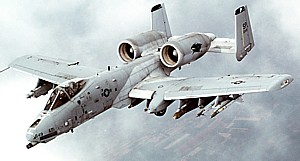 To cite another example, the US Congress was once faced with a proposition from the US Navy to buy many F-14 aircraft without a clear explanation of why. 'What would they be used for?' was the obvious question to which the answer received was apparently to support invading troops on the ground! Needless to say, the request was automatically and quickly denied.
To cite another example, the US Congress was once faced with a proposition from the US Navy to buy many F-14 aircraft without a clear explanation of why. 'What would they be used for?' was the obvious question to which the answer received was apparently to support invading troops on the ground! Needless to say, the request was automatically and quickly denied.
At the time, each supersonc F-14 cost close to $32 million per copy and where reducing it to this ground support role at minimal sppeds invited the prospect of several being shot down by ground fire. The US Army countered with a more realistic proposal called the A-10 'Warthog' and where this 'ugly subsonic gunship aircraft' has the pilot sat in a 'titanium bath' with a thirteen foot long 'Gatling Gun' beneath and firing shells with discarding sabot technology and using spent nuclear fuel as the solid high-density core. As an anti-tank, anti-ship weapon or troop support aircraft, this was a more cost effective option and used with huge success in both Iraq Wars.
My point in mentioning this is that there will always be a case for specialist aircraft of limited numbers to perform certain missions and where their existence and cost will high. The ideal of a one design suits all may become prevalent in the future but it's unlikely that a homogenous aircraft design can ever be developed without variations according to perceived need. We can't even get this with motor cars and where early first editions of some right hand driver Peugeot cars came to the UK with wipers designed for a left seat driver! Accidents later, the presumptious error was dealt with.
During the 1990s, and with the development costs of military aircraft soaring to unacceptable levels, several nations within the NATO Alliance began to recognise how homogenous design among weapons manufacture could deliver massive savings by means of mass production as opposed to specialist and unique requirements. Whilst obvious in terms of bullets and shells, the really expensive items like military jet aircraft represented a far more complex proposition.
Within the Joint Strike Fighter Initiative, the principal aim was and is to develop an aircraft with three variants; the first of which involves Air Force operations with land based runways. The second requirement involves elements of STOVL or better while the third is entirely maritime in format and using the conventional CATOBAR requirements as described above.
At the heart of the project are common design interchange abilty of engines and parts with shared cost of development. As an important part of this project, several globally renowned manufacturers were granted substantial monies to develop a prototype and where each was expected to compete with others before a decision to proceed further was taken.
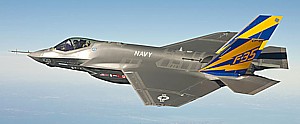 In 1996, McDonnell-Douglas was excluded on the basis that their design was too complex and leaving Boeing and Lockheed-Martin as the potential leaders in the race. At the crucual stage, Boeing's X32 was ugly in appearance and performance. At one stage, the X32 engines began to overheat as exhaust gases were redrawn through the engine. In sharp contrast, the Lockheed-Martin X-35B variant took off in less than 500 feet before conducting supersonic flight and then landed vertically; something that competitors could not emulate. Having said that, there were crucial reservations about some aspects of the technology and a final decision to award the contract to Lockheed-Martin was delayed until October 2001.
In 1996, McDonnell-Douglas was excluded on the basis that their design was too complex and leaving Boeing and Lockheed-Martin as the potential leaders in the race. At the crucual stage, Boeing's X32 was ugly in appearance and performance. At one stage, the X32 engines began to overheat as exhaust gases were redrawn through the engine. In sharp contrast, the Lockheed-Martin X-35B variant took off in less than 500 feet before conducting supersonic flight and then landed vertically; something that competitors could not emulate. Having said that, there were crucial reservations about some aspects of the technology and a final decision to award the contract to Lockheed-Martin was delayed until October 2001.
Although largely a US led project at the start, the JSF project has attracted additional attention and investment from many other countries. In 2001, the United Kingdom became signatory to the project and is currently the largest external investor outside that of the United States. Italy, Canada, Turkey, Australia, Norway, Denmark and the Netherlands are also investors.
In 2009, the US government declared that they were ready to buy 2,443 of the new F-35 Lightning II fighters whenever they were available. On 19th July 2012, British Defence Secretary, Phil Hammond indicated that the initial order for the F-35B would number forty-eight with these being jointly by the Fleet Air Arm and Royal Air Force. To date, none of these aircraft has entered service although recent test flights of the F-35B landing on the modest sized assault ship USS Wasp then taking off again without incident suggests the new aircraft will be in high demand and service in the near future.
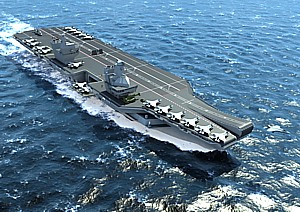 During the 1960s, a proposal to build two large carriers to replace 'HMS Eagle' and 'HMS Ark Royal' was rejected by the Labour administration in 1966. The 'Queen Elizabeth' and 'Duke of Edinburgh' had been rejected at an early stage but in 1970s, a proposal concerning the three 'small carriers' described above was accepted and the first was luckily in service when Margaret Thatcher assumed office in 1979 and in time to participate in the Falklands Conflict of 1982. Upon leaving office, John Major, the so-called 'grey man of politics' assumed her role and did a splendid job of restoring the national finances and left office with the Treasury in an advantageous role not seen for many years. He was defeated in a landslide poll in 1997 by 'New Labour' led by Tony Blair and Gordon Brown.
During the 1960s, a proposal to build two large carriers to replace 'HMS Eagle' and 'HMS Ark Royal' was rejected by the Labour administration in 1966. The 'Queen Elizabeth' and 'Duke of Edinburgh' had been rejected at an early stage but in 1970s, a proposal concerning the three 'small carriers' described above was accepted and the first was luckily in service when Margaret Thatcher assumed office in 1979 and in time to participate in the Falklands Conflict of 1982. Upon leaving office, John Major, the so-called 'grey man of politics' assumed her role and did a splendid job of restoring the national finances and left office with the Treasury in an advantageous role not seen for many years. He was defeated in a landslide poll in 1997 by 'New Labour' led by Tony Blair and Gordon Brown.
By the millennium year of 2000, 'New Labour' had frittered much of this advantage by way of generous tax credits for the unemployed, involvement in the first Iraqi war and more. By then, it was apparent that difficult economic times were looming despite claims of having beaten the cycle of 'boom and bust'. Despite this, two large aircraft carriers of the BAe/Thales design were ordered and with the F-35c aircraft carrier variant of Joint Strike Fighter Lightning II aircraft in mind. At just over 70,000 tonnes with a length of 280 metres long (920ft), they'll be the largest carriers in Europe and the largest ever ordered for the Royal Navy. Although fifty aircraft could be carried in this design, a more modest number is likely to be applied and close to forty would be a reasonable guess. They are still in building at this time of writing in 2013 and with sea trials expected around 2018 and commissioning circa 2020.
In 2007, Tony Blair wisely retired and left his former Chancellor, Gordon Brown, to face the heat. Using the same pretext that had allowed John Major to succeed Margaret Thatcher, the former Chancellor became his replacement without need for an election. In 2010, however, and much to the surprise of political commentators, Gordon Brown fared better than anyone expected and the result was that of a 'hung Parliament' leaving the third placed party to make a crucial decision about the future. For the first time in a generation, the Liberals held sway and ultimately chose to support the Conservatives in a coalition.
Upon assuming government in 2010, the Liberal/Conservative government inherited a country deep in debt and where cancellation of the aircraft carrier projects would have cost more than continuance. In large measure, the aircraft carrier projects were saved by cancellation clauses and where continued investment in the Joint Strike Fighter program might have been lost too.
In an island nation where the National Health Service represents the fourth largest manpower organisation in the World and where the educational budget is only slightly larger than that of defence, it was obvious that the latter would face serious revue. In the circumstances, the £5.9 billion cost of the aircraft carriers was a sore point but it was realised that cancellation would cost more and the projects have been allowed to proceed albeit with major revisions.
A military expenditure revue conducted soon after the coalition took power was far worse than anyone expected. The Nimrod fleet of Early Warning Aircraft and Harrier VTOL jets were scrapped in entirety and 'HMS Ark Royal' was decommissioned. 'HMS Ark Royal' was stripped and then fetched three million pounds in scrap value before being towed to a yard in Turkey.
'HMS Illustrious' was retained as a helicopter carrier while 'HMS Ocean', a multi-role assault ship, was in refit but upon completion of this refit in July 2014, it was announced that HMS Illustrious would be decommissioned and in the hope that it might be sold and retained as a museum. Whether that outcome takes place remains to be seen at this time of writing.
Naturally, such drastic action suggests no fleet air arm flying jets in the near future but several pilots are training with the US forces and waiting for the day when they'll be training new pilots for the new 'Queen Elizabeth' class ships. In the meantime, it leaves a crucial gap in Royal Navy capability.
At present, design considerations for the 'Queen Elizabeth Class' have been altered at great expense. The original plan was to employ the F-35c marine variant of the Lightning II aircraft and thus affording greater homogeny with other NATO aircraft carriers using the CATOBAR system. In addition, the F-35c is able to carry a bigger weapons payload and have greater range than the F-35b STOVL variant now favoured by the UK government as means to reduce costs by having no catapult launch facility. Current intent is that the first of these new carriers will operate in STOVL mode despite this major shortcoming and loss of a major opportunity since both ships are expected to remain in service for a half-century. The 'Queen Elizabeth II' does have the guarantee of being commissioned into service around 2020 with sea trials starting around 2017 whilst the second ship, 'Prince of Wales' does not and where a revue in 2015 may suggest selling it to a 'friendly foreign power' with France being the preferred client.
Before closing this section, and writing in 2013, it worth mentioning how a ship of this size has the ability to lift two Chinook helicopters from the hanger without folded wings or two F-35b Lightning II aircraft in a single lift. As planned, the deck markings are for ten helicopter landing pads and where, in an assault role, 250 troops could be landed in a single flight. Airbourne Early Warning functions are expected to be conducted by the all-weather Merlin helicopter based 'Crowsnest' system in development.
The Queen visited the Rosyth dockyard in Scotland on 4th July to officially name the first ship and it was floated out of dry dock soon afterwards while work on the second ship began.
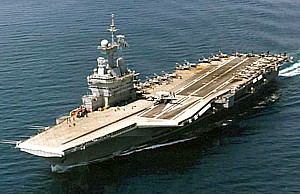 It's bizarre and ironic that French Marshal Ferdinand Foch is famously quoted in 1911 saying that "Airplanes are interesting toys but of no military value" and yet one of the two Clemenceau class aircraft carriers, commissioned from 1961 until 2000, was named after him. Even today, the ship survives under the name of the 'NAe Sao Paulo' of the Brazilian Navy and where reference has already been made to in this text.
It's bizarre and ironic that French Marshal Ferdinand Foch is famously quoted in 1911 saying that "Airplanes are interesting toys but of no military value" and yet one of the two Clemenceau class aircraft carriers, commissioned from 1961 until 2000, was named after him. Even today, the ship survives under the name of the 'NAe Sao Paulo' of the Brazilian Navy and where reference has already been made to in this text.
As the millennium year loomed, however, the requirement for the 'Marine Nationale' prompted the bold decision towards an indigenous design of aircraft carrier powered by nuclear energy.
In many ways, this made great sense since France has never had much in the way of coal reserves and where a huge proportion of the national energy requirements have been met by means of nuclear power stations and hence more engineers better able to maintain facilities of that kind. In current times, and where the energy question has arisen in Britain, it has become increasingly obvious that a core of nuclear reactors will be needed in Britain and where need for French cooperation will be vital since Britain doesn't have sufficient nuclear skilled people!
Having said that, building the 'Charles de Gaulle' proved to be a massive undertaking! Test flights aboard the former aircraft carriers involving the E-2 Hawkeye Airborne Early Warning aircraft proved to be of little value and where the need to extend the flight deck to meet such need meant a massive expansion of the budget. Even when commissioned, the ship was less than outstanding in performance during the early part of its career.
Power failures when running at flank speed and the loss of a propeller were just a few of the features. In the latter case, recovery of the lost propeller revealed design defects and where the manufacturer had gone out of business. She was refitted with propellers from the stock taken from 'Clementeau' class aircraft carriers at a cost of three knots maximum speed. It's most notable participation to date has been the Libyan campaign. It's the first nuclear powered surface vessel built by France and is currently the largest warship in Europe. It is also the only nuclear powered aircraft carrier ever to have been built outside that of the United States of America. On a regular basis, the 'Charles de Gaulle' carries an air arm composed of Dassault-Breguet Super Étendard, Dassault Rafale-M and E-2c Hawkeye fixed wing aircraft and which is supported by EC275 Caracal and AS532 Cougar helicopters. It operates in the CATOBAR mode and is thus more able to meet interoperability with NATO carriers operated by the US.
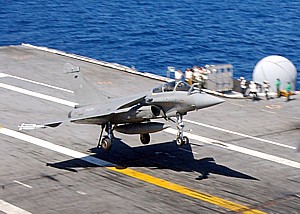 Ideally, the French Navy would like a second, conventional powered aircraft carrier akin to that being built for the British Royal Navy but plans for that have been abandoned on economic grounds in recent times.
Ideally, the French Navy would like a second, conventional powered aircraft carrier akin to that being built for the British Royal Navy but plans for that have been abandoned on economic grounds in recent times.
On Christmas Eve, 2010, Russia signed up for two French designed multi-role assault ships of the Mistral class and where three of these are already in service with the French Navy. These can deploy sixteen Tiger helicopters, four landing barges and 450 soldiers including seventy vehicles in an assault role. They even have well-equipped 69 patient hospitals aboard but one can only hope that's one facility deemed as superfluous in the future!
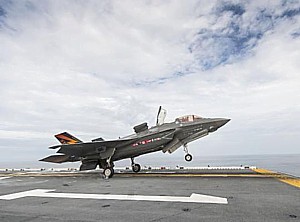 "To Jaw-Jaw is better than War-War," is a phrase allegedly said by Nobel Prize winner and British wartime leader Sir Winston Churchill at a White House Luncheon in 1954 and it's hard to disagree with experience and common sense.
"To Jaw-Jaw is better than War-War," is a phrase allegedly said by Nobel Prize winner and British wartime leader Sir Winston Churchill at a White House Luncheon in 1954 and it's hard to disagree with experience and common sense.
It's hard to realise how, during the Falklands Crisis, both sides agreed to a 'demilitarised zone' for use by 'hospital ships' and where casualties of both sides were regularly transferred between each other. If we can agree on that level then why not concerning the more central and crucial issues? Is compromise impossible in such circumstances? Is conflict and war the ultimate failure of conversation and diplomacy? Just how much is dictated by the preparation for war as an inevitable consequence?
The shortest war in history was the Anglo-Zanzibar War of 1896 and followed just a few days after the local Sultan died and was suddenly replaced by another of hostile intent to British rule and influence. Diplomacy to avert conflict ended with a British ultimatum with a time limit set for nine o'clock on the morning of 27th August. Around 2,800 Zanzibaris gathered to defend the Royal Palace and established four artillery pieces and use of a shore battery as part of their defence against 150 marines and 900 loyal British Zanzibaris assembled at the harbour. A Royal yacht and two small boats put to sea against three British cruisers and two gunboats. At 9:02am, an onshore bombardment began and the shore battery, artillery guns and the three boats were destroyed. By 9:40am, the war was over and the palace was in ruins. The 'would be' Sultan found exile in German East Africa (current day Tanzania) and never returned. It was another example of 'gunboat diplomacy' applied in many theatres of the British Empire and where Adolph Hitler and Germany are still regarded as saviours in several nations. Even our closest modern allies have been at loggerheads on differing occasions but its heartening that, with time, even the bitterest of enemies can find the road back to peaceful co-existence given sufficient time to rebuild bridges of trust and friendship.
In the next part of this series, it's all about the United States of America and how this former British colony ultimately formed the posture of 'forward defence' with an aim to ensure that no war would ever be fought on American soil. Today, the backbones of this philosophy are the mighty nuclear powered 'super carrier task forces' deployed around the World and why the US operates more than half of all fleet carriers in existence and with more in building!

